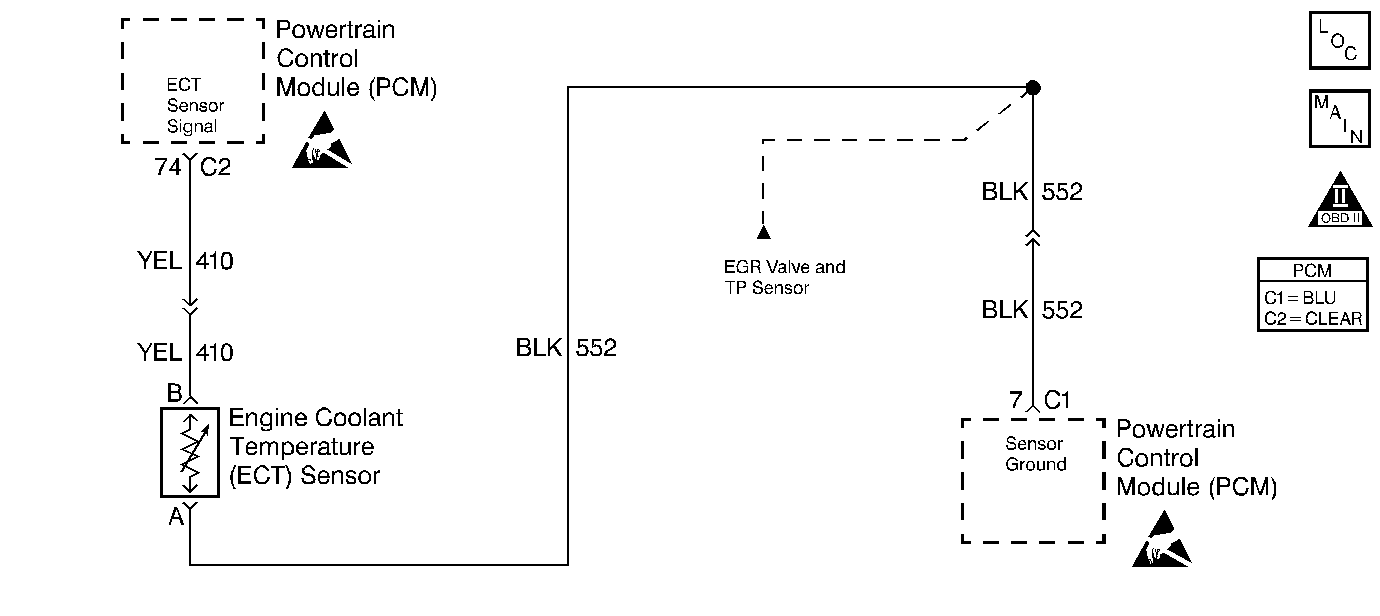
Circuit Description
The Engine Coolant Temperature (ECT) sensor is a thermistor, a sensor whose resistance varies with temperature. The ECT sensor signal is on CKT 410 and sensor ground on CKT 808. As the temperature increases, sensor resistance decreases. High coolant temperature will result in low signal voltage on CKT 410. DTC P1115 sets because the coolant temperature cannot be less than -38°C (-36°F) when IAT is greater than -5°C (23°F) or the vehicle has been driving long enough for the ECT temperature to increase above -38°C (-36°F).
Conditions for Running the DTC
| • | DTCs P0112, P0113, P0117 and P0118 not set. |
| • | IAT sensor value -5°C (23°F) or greater. |
| • | DTCs P0112, P0113, P0117, P0118, P0122 and P0123 not set. |
| • | Engine running and throttle angle 7 degrees or greater for at least 3.5 minutes. |
Conditions for Setting the DTC
ECT -38°C (-36°F) or less.
Action Taken When the DTC Sets
| • | The Malfunction Indicator Lamp (MIL) will not illuminate. |
| • | No message will be displayed. |
Conditions for Clearing the DTC
| • | A History DTC will clear after forty consecutive warm-up cycles with no failures of any non-emission related diagnostic test. |
| • | A Last Test Failed (current) DTC will clear when the diagnostic runs and does not fail. |
| • | Use a scan tool to clear DTCs. |
| • | Interrupting PCM battery voltage may or may not clear DTCs. This practice is not recommended. Refer to Clearing Diagnostic Trouble Codes in Powertrain Control Module Description . |
Diagnostic Aids
If fault is not present perform Powertrain Ground Check and also review Failure Rec. to determine conditions under which and how long ago the DTC set.
If a faulty sensor is suspected refer to Temperature vs Resistance table.
Test Description
Number(s) below refer to the step number(s) on the Diagnostic Table.
-
If DTC P0116 is also set, diagnose it first because it may pinpoint a faulty ECT sensor.
-
Checking for an intermittent open or short to voltage in the ECT sensor signal circuit or the ECT sensor ground circuit that may cause a high ECT sensor reading.
Step | Action | Value(s) | Yes | No |
|---|---|---|---|---|
1 | Did you perform the Powertrain On-Board Diagnostic (OBD) System Check? | -- | Go to Step 2 | |
Connect the scan tool. Is DTC P0116 or P0118 also set? | -- | Go to DTCs that are set | Go to Step 3 | |
3 |
Was terminal contact repaired? | -- | Go to Powertrain Control Module Diagnosis for Verify Repair | Go to Step 4 |
4 |
Was terminal contact repaired? | -- | Go to Powertrain Control Module Diagnosis for Verify Repair | Go to Step 5 |
Was a repair made to any circuit? | -- | Go to Powertrain Control Module Diagnosis for Verify Repair | Fault not present. Refer to Diagnostic Aids |
